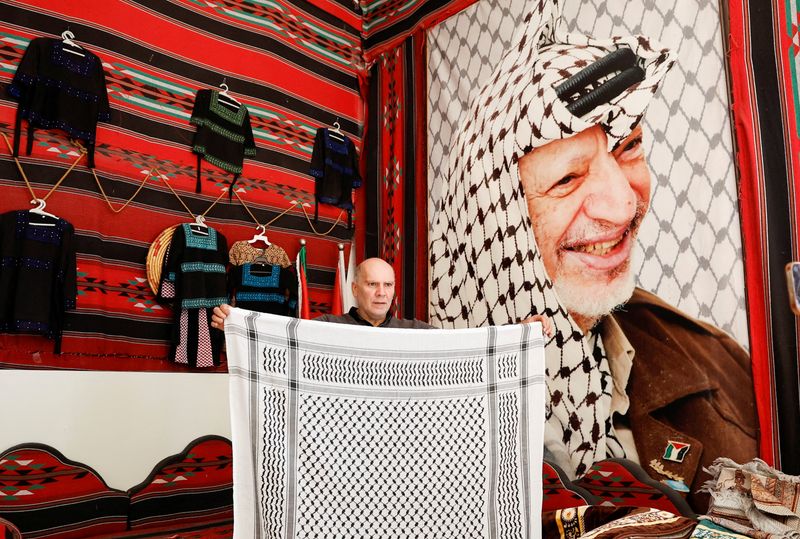By Andrea Shalal, Andrew Hay and Siddharth Cavale
WASHINGTON (Reuters) - A growing number of Americans are donning the keffiyeh, the distinctive patterned scarf that's closely linked with Palestinians, to demand a ceasefire to Israel's attacks on Gaza or to signal their support for Palestinians.
Sales of the scarves have jumped since the Israel-Hamas war began in October, U.S. distributors say, even as keffiyehs have been forcibly removed by security forces at some protests and wearers report being targeted for verbal and physical abuse.
"It was like a light switch. All of a sudden, we had hundreds of people on the website simultaneously and buying whatever they could," said Azar Aghayev, the U.S. distributor for Hirbawi, which opened in 1961 and is the only manufacturer of keffiyehs left in the Israeli-occupied West Bank.
"In two days, the stock that we had was just gone, and not just gone, it was oversold."
Hirbawi, which has patented its brand, sells scarves internationally via its U.S. and German websites and on Amazon. All 40 variations on the U.S. website, which include many in bright colors as well as the traditional black and white, are sold out, Aghayev said.
Unit sales of keffiyeh scarves have risen 75% in the 56 days between Oct. 7 and Dec. 2 on Amazon.com (NASDAQ:AMZN) compared with the previous 56 days, data from e-commerce analytics firm Jungle Scout showed. Searches for "Palestinian scarf for women" rose by 159% in the three months to Dec. 4 compared with the previous three months; searches for "military scarf shemagh," "keffiyeh palestine" and "keffiyeh" rose 333%, 75%, and 68%, respectively.
The keffiyeh, with its fishing net pattern, is common throughout the Arab world, with roots dating as far back as 3100 BC. It first came to symbolize Palestinian resistance during the 1936 Arab Revolt against British rule and later became the signature head gear of Palestine Liberation Organization leader Yasser Arafat.
While Hirbawi is the best-known manufacturer, others include small artisans and global copycats; luxury goods maker Louis Vuitton sold a version in 2021.
U.S. supporters of the Palestinians and Israel have faced threats and attacks since the Middle East conflict began, with Jewish Americans seeing an increase in antisemitism and Muslim Americans an uptick in Islamaphobia.
Hazami Barmada, 38, a former United Nations official who lives in Virginia, wore one recently as she protested outside the White House and in Washington's Georgetown neighborhood in support of a ceasefire in Gaza.
Donning the scarf felt like a "superpower," she said, reconnecting her with her Palestinian heritage and offering a symbolic link to children in Gaza. But she believes it also attracts verbal abuse. "I'm taking a calculated risk," said Barmada.
SECURITY TARGET, VERMONT SHOOTING
At New York City's Rockefeller Center Christmas tree lighting in November, one attendee who wore a keffiyeh had it yanked off by a security officer - a moment captured in a Reuters photograph.
The security officer approached protesters at the front of the crowd who had a banner, a Palestinian flag, and one wearing a keffiyeh, and grabbed all three items, taking the keffiyeh from around the neck of the protester, photographer Eduardo Munnoz said.
The Council on American-Islamic Relations has documented several instances of people targeted for wearing a keffiyeh, from a father assaulted on a Brooklyn playground to a Harvard graduate student who was told she was wearing a "terrorist" scarf.
In the most serious incident, three college students of Palestinian descent - two wearing keffiyehs - were shot in Burlington (NYSE:BURL), Vermont, while taking a walk last month. Hisham Awartani, 20, is paralyzed from the chest down. Authorities have charged a suspect with attempted murder in the shootings and are investigating whether it was a hate-motivated crime.
Tamara Tamimi, the mother of one of the students, Kinnan Abdalhamid, told CBS News last week that she believed they would not have been targeted if they had not been "dressed the way that they were and speaking Arabic."
Students for Justice in Palestine (SJP), a group at the center of U.S. campus activism since Hamas attacked Israel on Oct. 7. has been encouraging students to “wear your keffiyeh” in solidarity with the students shot in Vermont in the week after the incident.
Still, in Houston, Texas, SJP member Anna Rajagopal said she and other members had not worn their keffiyeh outside spaces they considered friendly to Arabs and Muslims since October, after people waving Israeli flags surrounded a cafe they were in, screaming insults.
"Myself and a friend have been cognizant of taking off our keffiyehs after leaving Palestinian, Arab spaces to be safe," said Rajagopal, 23, a freelance writer who graduated from Rice University in May and is also a member of Jewish Voice for Peace, a group that advocates for Palestinian independence.
Demand is unabated, though, sellers say. "If we could stock 20,000 keffiyehs, we would have sold them," said Morgan Totah, founder of Handmade Palestine, a group based in the Palestinian city of Ramallah that sells local artisans' wares online.
